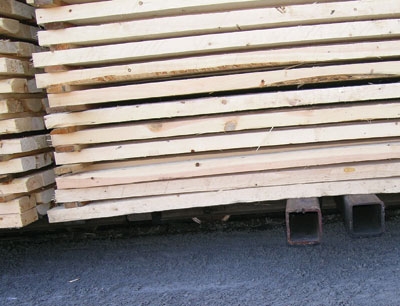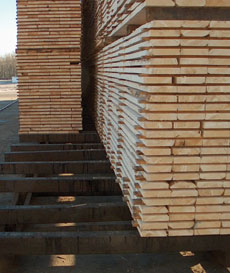
New Gear
Equipment
Sawmilling
Five Easy Pieces to a successful drying operation
Doing the basics right is a good formula for success in most endeavours, but is especially true in lumber drying. Drying takes place in a big black box over a period of many hours or days, and so mill operators do not always make the connection between cause and effect.
November 25, 2011 By Peter Garrahan
 The good and the bad and ugly. Good piling practices and strapping Doing the basics right is a good formula for success in most endeavours
The good and the bad and ugly. Good piling practices and strapping Doing the basics right is a good formula for success in most endeavours
At FPInnovations – Forintek Division, we are working on a project to help make that connection. The project is called Best Drying Practices, and one of the objectives is to develop tools and methodologies to quantify the impact of various actions (or inactions) on drying performance. An earlier project developed techniques to track lumber, and monitor its progress through the manufacturing process. The current project will focus on evaluating lumber to help justify the implementation of various “best drying practices.”
Despite the existence of kiln operator courses and other training materials, one of the most common faults we find when visiting drying operations is a failure to follow many of the basic good drying practices. This article highlights 10 of those good drying practices that are easy to implement – even in a time of deep financial crisis in the industry. In fact, current markets should be an incentive to implement them. Although not as captivating as the old Jack Nicholson movie Five Easy Pieces, our Ten Easy Pieces will still be helpful. Fittingly, the first five are published in this issue, and the second five will be published in the next issue (or can be viewed immediately at www.canadianwoodproducts.ca).
No. 1 – Lumber Piling
As shown in the photo below, how you pile lumber can have a significant effect on final lumber quality. Wood is a plastic material and will bend if loads are applied at unsupported points – especially when drying at elevated temperatures. The following are all essential in producing good quality packages of lumber:

Good sticker alignment.
- Spacing of stickers appropriate to the product/thickness of material being dried. Our studies show that two-foot spacing pays off when drying two-inch premium grade material or lumber that is known to be more warp prone.
- Stickers of an appropriate length – not too long or too short.
- Eliminate stickers that are broken, too thick, or too thin.
- Pile single lengths per package whenever possible, or implement box piling for mixed or random length situations.
- Plastic strapping will help maintain integrity of packages, and prevent loss of material in the yard with handling.
No. 2 – Green Storage/Air Drying
Assuming the lumber is piled correctly, there should be a strong incentive to maintain, or even improve on, the quality of the lumber during the time that it is held in inventory before drying. Whether the intent is to air dry or just store for a few days, this step in the operation can have a significant impact on final product quality. A well-prepared and maintained yard will facilitate package handling and placement. Deep ruts slow down (usually) equipment operators and cause jostling and jarring of packages. This results in well-piled packages becoming poorly piled packages, and increases the loss of stickers and boards.
In most mills, lumber can sit for up to a few weeks while building up inventories of product for kiln loads. This time can be used to your advantage if the yard is well laid out, and packages are spaced to provide good air drying. Jamming too much material into too small a space will not only reduce the potential to get some initial drying, but will also increase the risk of developing blue stain or mold. Bunk alignment with stickers is just as important here as in the kiln. Sticker breakage can be minimized by maintaining good lateral spacing between packages.
No. 3 – Kiln Loading/ Baffling
If package integrity has been maintained up to the point of loading the kiln, it is much easier (as well as there being more incentive) for operators to do a good job loading the kiln. The first step here is to produce good square loads that will block all openings across the kiln from top to bottom, and from end to end. In track kilns this can be done by making sure that packages are offset to avoid openings from one side of the load to the other whenever package lengths do not fill the kiln completely. Avoid using partial packages that will leave gaps above the load. Maintain a “chimney” of two to four inches wide between adjacent packages to avoid blocking airflow from misaligned stickers (see photo). Bunks must be placed so that the rows of stickers are aligned.
One of the easiest ways to get more airflow from your fans is to ensure the load is properly baffled. Bypass air reduces the overall efficiency of your airflow system, slows drying, contributes to uneven drying, and is a waste of energy. If your baffles are broken, repair them; if they are non-existent, replace them. This is a relatively low-cost item that will provide a good payback.
No. 4 – On Schedule
Every kiln operator should have a library of drying schedules to pick from. When drying SPF, many of these schedules will be variations on the same theme, but each addresses a different situation. For example, a drying schedule for well air-dried material can be more aggressive and therefore much shorter than a schedule for green material.
Schedules for mixed products or species should generally be gentler (lower temperature, higher humidity) and therefore have a longer drying time. When drying hardwoods or high-valued softwoods, there are many drying schedules available in the literature. For dimension lumber, schedules tend to become site specific. Later this year we will be publishing an SPF Dry Kiln Operator’s Manual that will include more guidance on the subject of drying schedules for this species mix.
I have often referred to drying schedules as your Christmas wish list, but as we all know, you don’t always get what you asked (or hinted) for. Therefore, it is important to follow the progress of the kiln load, and make sure that the schedule you selected is indeed being followed. Kiln deficiencies, energy interruptions, or control system problems are all reasons why the kiln conditions you prescribe may not be met. If you are going to select a schedule for a specific reason (i.e., productivity, better quality, etc.), you should do whatever you can to make sure that those schedule conditions are achieved.
No. 5 – Uniform Drying Conditions
Along with achieving the appropriate drying conditions, it is equally important to ensure that those drying conditions are maintained uniformly throughout the kiln. For most kilns, airflow should be consistent around the load to within plus or minus 100 fpm of the average value. If it isn’t, find out why. Is it baffling, loading, or simply a fan not working properly?
Uniformity of dry-bulb temperature is also essential. It should be obvious that zones that are consistently hot will dry faster and achieve a lower moisture content than the rest of the load. At any point in the drying process, the dry-bulb temperature should be no more than +/- 5° F from the set point when drying softwood dimension lumber (+/- 2° F for hardwoods and other value-added products). If your temperature extremes are outside of these guidelines, try to find the cause of the problem and correct it. The usual culprits are things like blocked or defective steam traps, or a poorly balanced heat distribution system in a direct-fired kiln.
Relative humidity or wet-bulb temperatures are typically less variable in a dry kiln. If you have proper control and uniformity of both airflow and dry-bulb temperature, uniformity of the wet-bulb temperature will usually not be a problem.
Look to Canadian Wood Products March/April 2008 for Part 2 of this article, with tips on preventive maintenance, tighter kilns, final MC control and stop points, dry yard management, getting the most from your in-line moisture meters and more, or get a sneak peek at Part 2 at www.canadianwoodproducts.ca. Peter Garrahan is a lumber drying specialist with FPInnovations, Forintek Division, based in Ottawa, ON, and wrote this article specifically for Canadian Wood Products Magazine. He can be reached at (613) 523-1232, peter.garrahan@ott.forintek.ca
Print this page